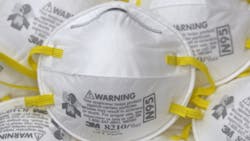In order to further reduce virus exposure in the workplace, OSHA has released a video that demonstrates proper donning and doffing of respirators.
The video follows the agency's interim guidance involving the decontamination of filtering facepiece respirators (FFR), which was published on April 27.
The widespread scarcity of personal protective equipment (PPE) has required reuse in healthcare settings across the country. This makes proper use and removal ever more critical for employees in healthcare settings and those with direct exposure to the novel coronavirus.
Patrick Kapust, acting director of the Directorate of Enforcement Programs, previously said in a memorandum, "Employers should investigate the effectiveness of any particular decontamination method used for the specific filtering facepiece respirator model to be decontaminated. Employers should be able to demonstrate the effectiveness of any decontamination method used against the likely contaminant(s) (i.e., pathogens) of concern, and that the decontamination method used does not produce additional safety hazards."
OSHA recommends the following seven steps for proper respirator use:
1. Wash hands with soap and water or alcohol-based hand rubs containing at least 60% alcohol before putting on and after removing the respirator;
2. Inspect the respirator for damage;
3. Cover mouth and nose with the respirator and pull strap over the head so that it rests at the back of the head. A second strap should rest at the back of the neck. Use the metal nose clips to mold the respirator to the shape of the nose;
4. Adjust the respirator by placing both hands over it and inhaling and exhaling. Readjust the straps if air leaks from the respirator’s edges;
5. Avoid touching the respirator while wearing it;
6. Remove the respirator by grabbing the strap(s) from behind. Do not touch the front; and
7. If the respirator does not need to be reused because of supply shortages, discard it in a closed-bin waste receptacle.
A poster complementing the video is available in both English and Spanish.
About the Author

Stefanie Valentic
Stefanie Valentic was formerly managing editor of EHS Today, and is currently editorial director of Waste360.
